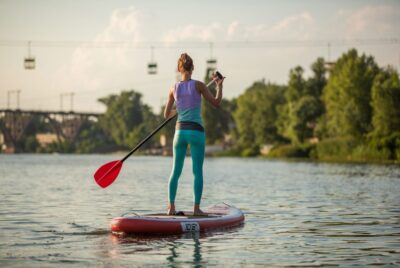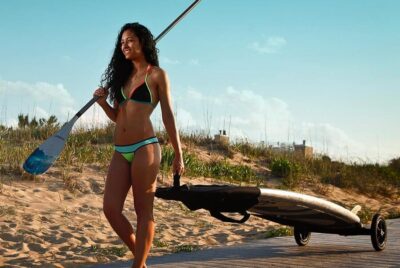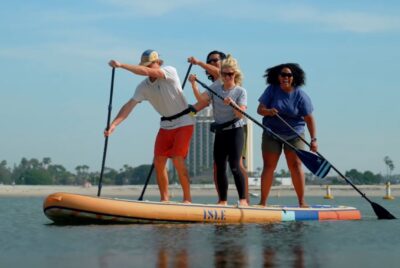Is Paddleboarding Hard? Learn To Balance Easily With This 5-Minute Guide
*We may earn a commission for purchases made using our links. Please see our disclosure to learn more.
Is paddleboarding hard? No, it doesn’t have to be if you have the right instructions.
As a paddle boarder, I can’t count how many times I’ve met people who are curious about this water sport but hesitate to try it because they think it might be difficult.
That’s why – In this article, I aim to debunk the myth that paddleboarding is hard and provide helpful suggestions on how to make it easy. By understanding the basics, overcoming initial challenges, and following practical tips, you can learn to balance and have fun…Fast!
| Looking for our best paddle board product recommendations? Check the Paddleboard Insiders Buyer Guides |
Table Of Contents
Is Paddleboarding Hard?
Overcoming Initial Challenges
While paddleboarding may seem daunting at first, it’s important to remember that like any new skill, it requires practice and patience. One of the initial challenges is finding your balance on the board. Start in calm, shallow waters and use a wide, stable board designed for beginners. Practice kneeling first, then gradually transition to standing up. This will help you build confidence and stability.
Mastering Balance and Technique
To make paddleboarding easier, focus on mastering your balance and technique. Keep your feet parallel, hip-width apart, and distribute your weight evenly. Engage your core muscles to maintain stability. Start with small, controlled paddle strokes, keeping the blade fully submerged in the water. As you gain confidence, you can experiment with different stroke techniques and maneuvers.
But like it is with anything, you might fall off a few times but the important thing is to get back on.
TIP: Read this article for our detailed guide on how to stand on a paddleboard so that you’re ready to get going fast.
Making Paddleboarding Easy:
Choosing the Right Board
Selecting the appropriate paddleboard can significantly enhance your experience. For beginners, opt for wider and longer boards that offer better stability. Inflatable paddleboards are also a great choice due to their durability and portability. Consider the board’s weight capacity, as it should support your weight and any additional gear you may carry.
For your first time paddelboarding, I recommend the inflatable boards because they have the perfect mix of stability and maneuverability so they will be easiest to get up on. And because of the material it will be also easiest to transport.
My Favorite Paddleboards Of 2025:
* Roc Inflatable SUP (Best Budget SUP OF 2025)

Where To Buy: Amazon
Why I Love It:
– Has a large non-slip comfort deck that can easily fit you and even an extra person
– Extremely high quality material that won’t get scuffed and damaged.
– 16.25 inch width makes it very stable
– It looks great!
* Portal 11’6″ Paddle Board (Best Overall SUP)
Where To Buy: Amazon
Why I Love It:
– 33 inch width gives it amazing width and stability.
– It has a depth of 6 inches that increases the weight capacity of the board to over 300lbs without sacrificing stability.
– This board has ample space along with a non-slip deck pad that is perfect for beginners
– It comes with everything included and a 2 year warranty.

* MYBOAT 11’6″Extra Wide SUP (Best Full Length Deck)

Where To Buy: Amazon
Why I Love It:
– This board is extra long and extra wide which is ideal for beginners (because it’s super stable)
– This board was designed for yoga so it’s super stable
– It comes with everything included and a 1 year warranty.
Finding the Ideal Location
When starting out, choose a location with calm waters and minimal currents. This will make it easier to practice balance and paddling without excessive challenges. Look for beginner-friendly spots, such as lakes or calm sections of rivers, where there are no obstacles or strong winds. As you gain experience, you can gradually explore more diverse environments.
Read this article for an interactive guide to help you find your next ideal location.
Start with Calm Waters
Beginners often find it easier to learn paddleboarding on calm, flat waters. This minimizes external factors that could affect balance and stability. Avoid venturing into open ocean waters or areas with strong currents until you have developed a good understanding of your capabilities and feel confident in your skills.
Learning Basic Paddle Strokes
Mastering basic paddle strokes is essential to propel yourself efficiently on the water. The forward stroke is the most fundamental, where you reach forward and push the paddle blade through the water. The reverse stroke helps you slow down or go backward. Experiment with different strokes, such as the sweep stroke and the draw stroke, to improve maneuverability.
Here is a great video guide on how to learn the basic paddle strokes:
Understanding Paddleboarding
What is Paddleboarding?
Stand-up paddleboarding (SUP), is a water activity that involves standing on a large board and propelling yourself forward using a paddle. It offers a unique way to explore water bodies, such as lakes, rivers, and even oceans. Paddleboarding can be enjoyed for leisure, fitness, or as a means of transportation.
Here Are The Benefits of Paddleboarding
Before delving into the difficulty level of paddleboarding, it’s important to highlight its numerous benefits. Paddleboarding provides a full-body workout, engaging your core, arms, and legs. It improves balance, coordination, and strengthens muscles. Additionally, being out on the water offers a sense of tranquility and connection with nature, promoting mental well-being.
Building Core Strength
To make paddleboarding easier in the long run, focus on building core strength. Engaging your core muscles helps you maintain balance and stability on the board. Incorporate exercises such as planks, squats, and rotational movements into your fitness routine. Strengthening your core will not only enhance your paddleboarding skills but also prevent potential injuries.
If you struggle with your core fitness and want to improve it for paddleboarding, then this is a great guide that I’ve found to help you do that.
Some Essential Safety Tips for Paddleboarding
While paddleboarding is generally safe, it’s crucial to prioritize your safety on the water. Wear a personal flotation device (PFD) or a life jacket at all times, especially if you’re in unfamiliar or open waters. Check weather conditions and be mindful of wind and currents. Inform someone about your paddling plans and avoid paddling alone whenever possible. Lastly, familiarize yourself with basic water rescue techniques.
| Here are the top safety accessories for paddle boarding: The 23 Best Paddleboard Accessories That You Need In 2025 |
Conclusion
In conclusion, paddleboarding is not as hard as it may initially seem. By understanding the basics, overcoming initial challenges, and following practical tips, you can make it an enjoyable and accessible activity. Choose the right board, find beginner-friendly locations, start in calm waters, and focus on building core strength. With practice and perseverance, you’ll soon discover the joy of gliding across the water on a paddleboard.
| Looking for insider guides to some amazing paddle boarding locations? Check the Paddleboard Insiders Location Guides |
FAQs
Is paddleboarding suitable for beginners?
Yes, paddleboarding can be enjoyed by beginners. Start with wide, stable boards and practice in calm waters to build your skills.
Do I need prior experience to try paddleboarding?
No, prior experience is not necessary. Paddleboarding is beginner-friendly and can be learned with practice and guidance.
How long does it take to become proficient at paddleboarding?
The time it takes to become proficient at paddleboarding varies for each individual. With regular practice, most people can develop basic skills within a few sessions.
Can I paddleboard in rough waters or waves?
Paddleboarding in rough waters or waves requires more advanced skills and experience. It’s recommended to gain proficiency in calm waters before attempting challenging conditions.
What should I wear while paddleboarding?
Wear comfortable, weather-appropriate clothing and consider a rash guard or wetsuit if necessary. Apply sunscreen, wear a hat, and protect your feet with water shoes or sandals. Read this article for more information about the best paddleboard accessories.
Remember, paddleboarding is meant to be a fun and enjoyable activity. Embrace the learning process, stay safe, and make the most of your paddleboarding adventures!





